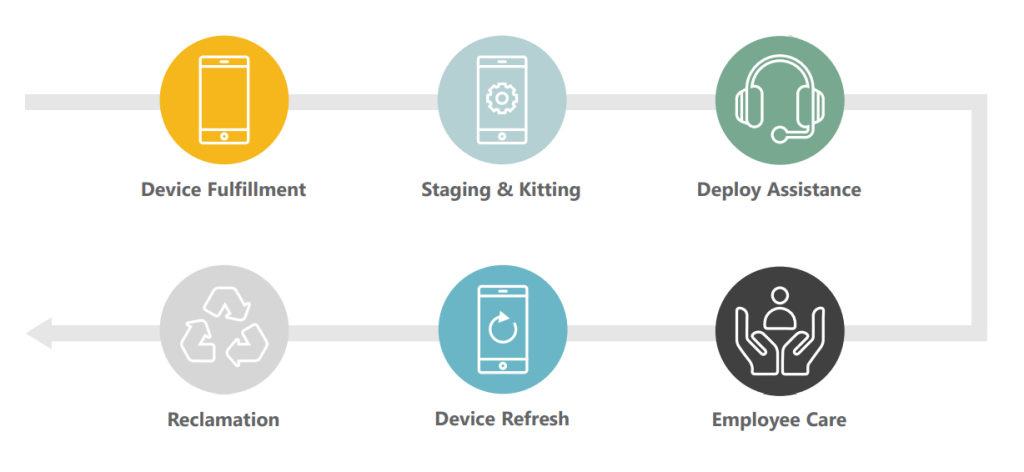From Acquisition to Retirement: The Comprehensive Cost of Managing Corporate Mobile Devices
Have you ever wondered what the all-in cost is of your company’s corporate mobile program? What is the true cost to your company, from activation to retirement? There are a lot of elements that impact the Total Cost of Ownership (TCO) for corporate devices – sourcing and acquisition, staging and kitting, accessories, management costs, applications that may need to be purchased to run on them, and more. Not to mention, the costs of carrier rate plans and monthly service charges, which is another complex topic.
Taking the monthly cost of service out of the equation, let’s look at the categories that impact the lifetime cost of a corporate mobile device, and dive into best practices for each.
Mobile Device Policy One of the biggest factors impacting your mobile device TCO is which device or devices your company chooses to deploy. Some companies decide to set standards for their devices versus allowing the employees to choose any device. If you are looking to set standards, options should be based on the current newest model – for example, the newest model (like the iPhone 16 or Galaxy S24) minus two models – meaning they would allow iPhone 14 and Galaxy S22 models.
These decisions will vary based on factors like security, processing needs, budgets, and your organizations personality. There is no right or wrong, however, if an enterprise requires all employees have the newest model of every device, that is significantly more expensive than allowing devices models that are a year or two old.
These decisions all play into a company’s Mobile Device Policy Guidelines. In addition to what models are permitted, the guidelines should determine how often devices are upgraded, and which employees are issued corporate devices. Factors may include job role, mobility needs, and seniority.
Device Acquisition When it comes to acquiring devices, organizations have several options, each with their own pro’s and con’s. Devices can be purchased from your carrier or directly from a supplier. If purchased from your carrier there may be discounts or contracted pricing that looks attractive, however, you may be giving up monthly discounts or committing that line for two or three years. Balancing these options is critical.
- How many lines are disconnected each year that incur a termination penalty and/or a fee for the remaining balance owned for the device?
- How many devices are purchased each year at full retail because the device being upgraded does not qualify for discounted pricing.
- Are damaged devices repaired or simply replaced? Who determines this direction and what is the cost?
- Does your organization capitalize the cost of devices or simply expense them? If capitalized, who manages the process to identify new devices and their cost.
- Looking at the total costs of acquiring mobile devices ties to your mobility policy, financial policy and business processes that support these policies.
Staging and Kitting Staging and kitting involves preparing devices for deployment, including pre-installing applications and configuring settings. When applications and company-mandated software are pre-installed onto a device, it saves an employee time on the backend after receiving the device. Many companies decide that it is worth the additional efficiency and time saved for their employees and ensures that all devices are properly configured according to company policies, with less room for user error that may occur when employees try to set it up themselves.
Configuring devices can be completed by in-house staff or by a third party that specializes in configuring laptops and mobile devices. This will incur a fee with the processing of the device. Some points to consider when deciding whether or not to use a third party to preconfigure your devices are cost and time.
- It may cost more than ordering and distributing the devices without outside help.
- It can also take more time to install the applications and prepare the device for deployment than it would without staging and kitting.
- However, these costs would most likely show themselves on the back end, when your employees or in-house resources are setting up the devices.

Device Lifecycle Management A robust Device Lifecycle Management program is necessary for dealing with both end-of-life processes and broken or lost devices. In both cases, a new device may be needed, and a retired or broken device may be recycled.
As part of your overall mobile device strategy, there should be a plan for handling broken and/or lost devices as well as warranty exchanges. Employees should have a clear protocol to follow to ensure that the least amount of time and money are wasted while the device is out of commission. Having a break/fix vendor that you trust is crucial. A reliable support system and process to provide a replacement quickly minimizes downtime when devices are broken.
When a device needs to be upgraded or is no longer supported, oftentimes it can end up in a desk drawer, forgotten. Companies that employ a reclamation program to proactively retrieve these devices, see much higher return rates for old devices, which leads to cost savings. There are many programs where old devices can be recycled and result in money back for enterprises. Additionally, increased recycling of e-waste contributes to company environmental scores and sustainability goals, which can sometimes come with tax breaks or other benefits from local and federal government.
Security and Compliance We have become too accustomed to data breaches, hacks and other attempts by bad actors to steal our data. It goes without saying that one of the most important areas and costs incurred with corporate mobile devices is all the security software, anti-malware and other security solutions needed to keep our data secure.
Mobile Device Management tools in addition to expenses in IT Support and Helpdesk costs must be factored in. This also includes any expenses for training and onboarding employees on how to use and manage their devices.
Bringing it All Together Understanding the Total Cost of Ownership for corporate wireless mobility programs is essential for IT managers in enterprise companies. By considering all these factors, organizations can better plan and manage their budgets, ensuring that their mobility programs are cost-effective and efficient. Properly managing these costs not only helps in financial planning but also ensures that employees have reliable and secure devices to perform their tasks effectively.
Each company must tailor their mobility program according to their needs, and cost savings can be found in any part of the mobile device lifecycle. OVATION offers full lifecycle management, staging and kitting, recycling and reclamation as a service, and more. Reach out to us today for a quote on streamlining your wireless mobility program!


